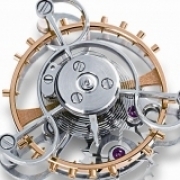I think my question was too multi cultural!! 

Paul, with your approval I feel this should be set aside and you set another one otherwise we will lose interest.
Machine Gun Kelly and the Red Baron never had such unpopularity and as for for a ruby substitute - well no wonder our sheep sheerer thought cars the future!! 
Apologies, too much travelling and enjoying myself at Cholmondeley this weekend.
At a guess I'd say this is to do with Frederick Wolseley and his general manager, Herbert Austin, and their involvement in sheep shearing machines. Austin also had an involvement with Sir Hiram Maxim.
For more details:
Irish born Frederick York Wolseley went to Sydney, Australia aged 17 in 1887 and founded the Wolseley Sheep Shearing Machine Company Ltd. in Sydney on 25th October 1887. While in Australia he worked at many jobs including being a station owner with a large number of sheep. He returned to Britain in 1889 after suffering manufacturing shortcomings from his sub-contractors. He set up at 58 Broad Street in Birmingham. Wolseley resigned in 1894. Herbert Austin, who had been manager of a engineering company in Australia, had suggested improvements to the shearing machines and returned to England in 1893 as a Wolseley employee. He was employed as an engineering inspector. Austin arranged the move in 1895 to larger premises at Sydney Works, Alma Street, Aston, Birmingham. In around 1896 Austin travelled to France to look at their motor industry. He liked the Léon-Bollée three-wheel voiturette and was soon building his own version, called the "Autocar Number One". It was advertised at £110 (UK Pounds) but only one was made. His second car was completed in 1897. A new company was formed in 1901; The Wolseley Tool & Motor Car Company Ltd. under the auspices of Vickers Sons & Maxim Ltd. and a new factory at Adderley Park, Birmingham was acquired to build Wolseley cars. In their first year Wolseley built 323 cars at the Birmingham factory while further cars were produced at the Crayford site. The Birmingham factory had been constructed in 1897 for Starley Brothers & Westwood Ltd. who were in the cycle trade. Austin applied for his first patents from these works in May 1901 for a handbrake mechanism and a pre-selector gearbox. Austin also patented a central steering motor body in January 1902.
Austin helped Sir Hiram Maxim (Inventor of the machine-gun) build a giant steam plane during the 1890's and Maxim's associates, Vickers, Sons & Maxim bought Wolseleys car division during 1901.
Plans were submitted to enlarge the works in February 1902 and further expansion occurred in most of the following years. Herbert Austin resigned in 1905 to start the Austin Motor Company Ltd. in Longbridge. Design now came under Siddeley influence and cars were marketed as Wolseley-Siddeleys.
After Austin left the company Alfred Remington made the patent applications. Remington was a draughtsman with The Wolseley Sheep Shearing Machine Company in 1900 and by 1902 was its Chief Draughtsman. Born in 1877 Remington designed the first submarine to use an internal combustion engine. He left Wolseley in 1920 due to ill health and died in 1922.
By 1909 Wolseley were building engines for rail cars, aircraft and marine uses. During the years 1909 and 1910 they expanded into the adjacent premises, Britannia Works, which had previously been used by Brown, Marshalls & Company Ltd. who had built railway carriages and were also waggon builders. (NB: double "G" is the correct spelling).





